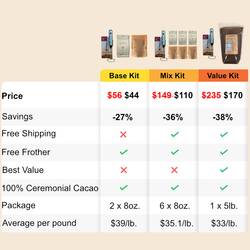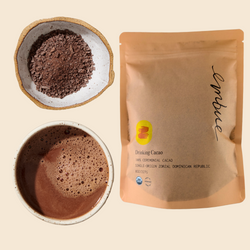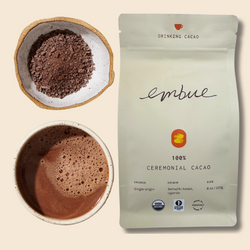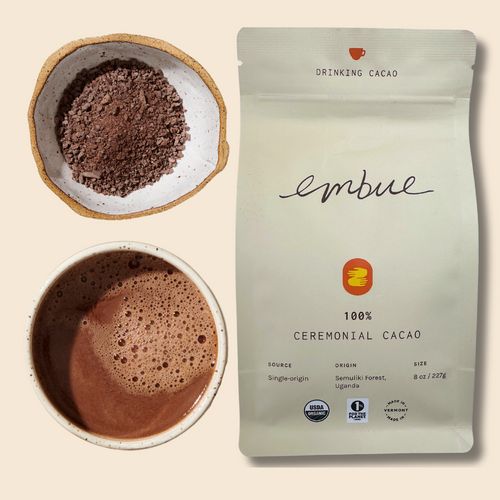Heavy Metals & Our Ceremonial Cacao
The Short Version
Yes, we definitely do test for heavy metals to make sure we’re in compliance with both California’s Prop 65 as well as EU regulations on the Parts Per Million (PPM) thresholds.
Here’s our latest full test numbers, from Oct, 2025:

As you can see, we fall well below the guidelines for both lead & cadmium, so on that front, you can be assured it’s something we take seriously and do test for, so that we can ensure our cacao is healthy.
As a quick visual reference for what a part per million is, 1 PPM is like 1 second compared to 11.5 days, or 1 step on a 568-mile walk. It’s minuscule.
The Longer Version
Heavy metals, in particular lead & cadmium, often get a lot of attention when it comes to chocolate and health. Over the years, various reports have made headlines with warnings about possible concerns related to the consumption of chocolate. The most recent of these, a Consumer Reports article, got a lot of international attention, as it portrayed a dire situation for eating chocolate.
Naturally, we received a lot of concerned emails asking us about our approach to heavy metals in cacao, if we test, and our thoughts on the issue. We’ve put this blog together to allay some fears and give context to these reports, which often grab attention and cause unnecessary alarm. In the age of clickbait and making headlines with fear, it’s more important than ever to be fully informed and careful of what conclusions we draw.
The concern raised in the most recent attention-grabbing article was based primarily on testing chocolate bars against California’s Maximum Allowable Daily Limit (MADL). Without giving any explanation for this choice of standard, it’s not surprising that most of the bars failed, as indeed would many food sources that we routinely consume, such as leafy greens, fruit juices, spices, and city water supplies, to name a few.
To get a better picture, we first need to look at where heavy metals come from in cacao. The heavy metals in cacao come primarily from the soils in which the cacao tree grows and the local conditions around fermentation & sun-drying. It used to be thought that the chocolate processing equipment might contribute to lead levels, but this has been shown to be inaccurate. The cadmium in cacao has been found to come from the soil, taken up by the tree, while the lead primarily comes from the soil and particulates that settled on the beans after harvest. The lead in particular then is concentrated in the husks (an important point we’ll return to later). That’s why when we do testing for heavy metals, it’s at the source that we test.
The cacao bean has a thin husk, much like an almond skin. Since the lead tends to enter from the outside, an important step in reducing lead levels is the removal of the husk. In our processing facility, the dried cacao beans are roasted and then winnowed, a process that removes the husk.
Heavy Metals Standards
In order to understand the Consumer Reports article, we need to take a closer look at the standard against which they are testing, CA’s MADL. It’s easy to show some simple bar graphs with Pass/Fail indicators, but more complicated to understand how they are making that assessment.
California’s MADL is the strictest standard that we know of. For example, the threshold it sets for lead is 0.5 micrograms per day. In contrast, the FDA sets the standard at 8.8 micrograms per day. That’s over 17 times higher. If the report had tested against the FDA standard, every single chocolate bar would have passed.
So, what is the MADL?
The MADL for lead is 0.5 micrograms per day and 4.1 micrograms for cadmium.
According to California’s Office of Environmental Health Hazard Assessment (OEHHA), “For chemicals that are listed as causing birth defects or reproductive harm, the “no observable effect level” is determined by identifying the level of exposure that has been shown to not pose any harm to humans or laboratory animals. Proposition 65 then requires this “no observable effect level” to be divided by 1,000 in order to provide an ample margin of safety.” So the standard for lead and cadmium is set by finding a level at which, for a more vulnerable population (pregnant mothers), there is no observable effect, and then dividing that number by 1000 for a ‘margin of safety’. There is no clearly stated scientific evidence that 1000 is an appropriate margin, and in fact, many other regulatory bodies have other takes on this.
For example, in response to the CR article, the Canadian Government stated: “However, according to the Canadian Food Inspection Agency (CFIA) and Health Canada’s assessments, the metal levels detected in those products don’t pose a risk to consumers at present….As a result, a need to establish maximum levels (ML) specific to cadmium and lead in chocolate products sold in Canada has not been identified”. This is from a government known for more stringent regulations. Likewise, the EU has set a limit of 2.5 micrograms/kg (of body weight) of cadmium per week, which translates to 24 micrograms per day for a 150lb adult. This is almost 6 times higher than the MADL. The EU also found it inappropriate to set a weekly limit for lead.
California’s approach to this issue has led some to call Prop 65 the “lawsuit mill” as the primary beneficiaries of these regulations are the lawyers making most of the profit from suing non-compliant companies. Consumers have learned to disregard the CA resident warning as so many products carry it that it’s hard to know which is actually hazardous, leading to warning fatigue, not a healthier population. If we want effective policy, it needs to be transparent and rooted in solid science so that we can make informed choices.
On top of not explaining the choice of standards, the CR article also didn’t give us context as to our average exposure through other dietary sources, an important reference if we’re to understand the applicability of the standard. While we have seen a steady decline in overall exposure to things like lead (for kids aged 1-3, it’s down from 43 micrograms per day in 1980 to 1 microgram per day in 2016, a 97% reduction), there are still many sources that have trace amounts in our diet. For example, natural green beans were found to have 28.75 micrograms of lead in a one-cup serving, and spinach to have 5.2 micrograms in an average adult serving. That’s over 50 times the MADL for green beans and 10 times for spinach. The EU estimates that the average 150lb adult has an intake of 46 micrograms of lead and 19.8 micrograms of cadmium per day, far higher than California’s MADL limit.
This isn’t to say that we shouldn’t care about the levels of heavy metals in our diet or environment, but that it’s important to understand the average exposures of modern life so we can make informed decisions about what we do consume. If there’s no reasonable way to entirely remove our exposure, then the question becomes what are the primary sources, what can we mediate, and then additionally, what steps can we take to help our bodies process any contaminants we get from the environment. None of that is well answered by the headline-grabbing Consumer Reports article. Instead, it has scared people without informing them on how to proceed.
The main question that is left unanswered, mostly because the science as of yet seems inconclusive, is what levels of daily intake will have an adverse effect on our health. More research into this is necessary, so that we can set standards based on something more than a 1000-fold less than any noticeable effect. It’s easier to see the effects of toxic exposure in the environment (with things like leaded gasoline or lead paint), but less clear about the minute levels in food sources that have been around for millennia.
As long-time cacao consumers ourselves, we pay close attention to these kinds of reports and love to stay up-to-date on the science of cacao. We consume cacao daily, and our health, and that of our kids, is a top priority. That’s why we test at origin for heavy metals, and make sure they are within the safe limits set by the more reasonable parts per million thresholds, seen in the chart above. We’ll continue to research and stay informed as the conversation continues, and we hope that you’ll take away a new understanding of heavy metals and cacao so that you can make your own informed decisions and not be scared by pseudo-research that doesn’t give you the whole picture!







